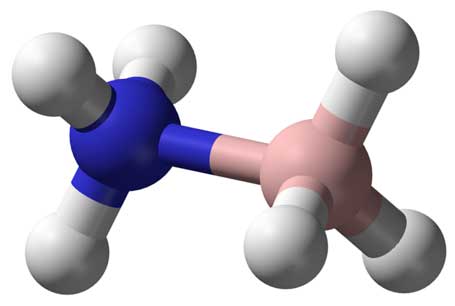
I’ve talked about the many advantages (and few disadvantages) of using ammonia borane (NH3BH3) in the past as a chemical carrier for hydrogen. Universities all over the world have been working on simple, effective and cheap methods to turn ammonia borane into hydrogen gas.
Now, student researchers from the University of Trento, Italy and the University of Mumbai, India think they have come up with an interesting, outside-the-box, safe and economical solution.
According to DNA India, “The students have come out with a catalyst, cobalt boride, which efficiently releases hydrogen from ammonia borane (NH3BH3) by hydrolysis. Wonderful results have been obtained by using the nano form of cobalt boride. The new catalyst can replace noble and costly metals which are presently used in hydrogen cars …
“… Instead of using the catalyst in powder form, the researchers have synthesised ‘cobalt nanoparticles-embedded boron matrix catalyst film’ for better results.”
So there you have it – chemical engineering and nanotechnology to the rescue once again. It’s important to note that ammonia borane is quite a flexible compound. First, it is one of the most stable, hydrogen rich chemical compounds around which can be created locally or transported over long distances safely.
Second, ammonia borane can be used to create hydrogen either inside or outside of a car. If used inside a car it can take the form of pellets or a slurry. Once spent, the remaining compound will need to be removed and rehydrogenated and used again and again.
Third, if used on-board a car it is a stable compound and would most likely be safer than carrying around a 10,000 psi tank of compress hydrogen gas and lighter than carrying around a metal hydride tank. The only downside of using ammonia borane on-board a vehicle is that there would have to be a simple way of disposing the spent material.
Fourth, if ammonia borane is created outside the vehicle, it can still be created onsite and on-demand or at least locally. The hydrogen can still be compressed and dispensed like is currently being done at current hydrogen fueling stations worldwide.
For me, the advantages far outweigh the disadvantages. For you, well, you can make up your own mind.
Does ammonia borane need heat exposure to release hydrogen or does the hydtogen release started by simply mixing with water?
Have cost estimates been made?
Is the process for making cobalt nano particles environmentally friendly?
How much ammonia borane would a vehicle have to carry typically?
Is this as dangerous as anhydrous ammonia to people?
How much cobalt is there in the world and where is it?